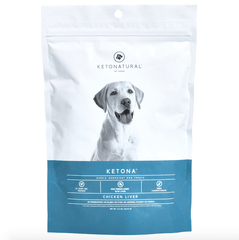Save Money, Save Your Dog.
Join Our Email List For Discounted Pricing and a Free Guide to the Science of Keto Dog Food.
Evaluating the Benefits of Canine Carbohydrate Restriction: “Sugar-Burning” vs. “Fat-Burning”
Original White Paper can be viewed here
Abstract
It has been theorized that a reduction in dietary carbohydrate intake serves to induce a host of metabolic changes in the domestic dog. These notably include an increased reliance upon free fatty acid (FFA) oxidation at the expense of glucose oxidation. This white paper briefly examines the role of diet in canine metabolism by evaluating the thesis that reduced carbohydrate intake will serve to increase reliance upon FFA oxidation in the metabolism of the domestic dog. We conclude that this thesis has unimpeachable evidentiary support and universal acceptance among leading scientific authorities.
Evidence Review
Domestic dogs rely upon several different metabolic pathways in order to produce the chemical energy needed to power their vital bodily functions and physical activities. These pathways, which broadly mirror those at work in the bodies of their human companions, rely foundationally upon food-derived chemical substrates, notably including glucose and FFAs.
Glucose is derived primarily from carbohydrate food sources such as corn, potatoes, rice, and wheat. (However, in the absence of exogenous carbohydrate, dogs will also synthesize a limited quantity of glucose through the process of gluconeogenesis.) During digestion, all carbohydrates are broken-down into individual glucose molecules. Once they enter the blood plasma, these molecules are either used immediately as metabolic fuel, or are converted into stable substrates and stored in the skeletal muscles, liver, and adipose tissue.
FFAs, on the other hand, are derived primarily from adipocytes (fat cells), where they are typically stored in a stable form. With very few exceptions, even the leanest dogs posses enough body fat to ensure that an abundant store of FFAs is almost always available to fuel bodily functions, should conditions otherwise permit. Accordingly, it is welldocumented that domestic dogs (as well as other canine species) can rely exclusively upon fat stores for metabolic energy for periods of several weeks or more with no ill effects.
To that end, experimental evidence has demonstrated that a number of factors influence the rate of glucose oxidation (as opposed to FFA oxidation) in the domestic dog. But the primary rate-limiting factor is the overall availability of plasma glucose. In short, if glucose is available in abundant quantities, dogs will rely upon it heavily to fuel bodily functions. But when plasma glucose levels are low (such as during periods of starvation or during dietary carbohydrate restriction), adipocyte-derived FFAs largely will be used instead. Our review has uncovered numerous published experiments documenting this phenomenon in dogs and none challenging it. The theory has also been explicitly endorsed in at least one leading veterinary nutrition textbook (Hand, et al.) as well as in the 2006 edition of the Nutrient Requirements of Dogs and Cats.
The existence of this biological phenomenon may have important consequences for pet owners. Since consumption of carbohydrates is the primary factor limiting the rate of glucose oxidation by domestic dogs, pet owners interested in reducing the extent to which their dogs rely upon glucose to meet metabolic demands may decide to reduce carbohydrate intake (or eliminate dietary carbohydrates altogether) in an effort to shift towards FFA metabolism. The arguments in favor of and against such a strategy are examined elsewhere in this white paper series.
OVERALL SUPPORT FOR PRIMARY THESES
10/10: Unimpeachable evidentiary support and universal acceptance by leading scientific authorities.
References
[1] Belo, et al. 1976. “Influence of Diet and Glucose Tolerance on the Rate of Glucose Utilization and on Gluconeogenic Enzyme Activities in the Dog,” Journal of Nutrition, 106:1465-74.
[2] Galassetti, P., et al. 1998. “A Negative Arterial-Portal Venous Glucose Gradient Decreases Skeletal Muscle Glucose Uptake,” American
[3] Hand, et al. 2000. Small Animal Clinical Nutrition, Marceline, MO: Walsworth Publishing Company. [4] National Research Council (U.S.) 2006. Nutrient Requirements of Dogs and Cats, Washington, D.C.: National Academies Press.
